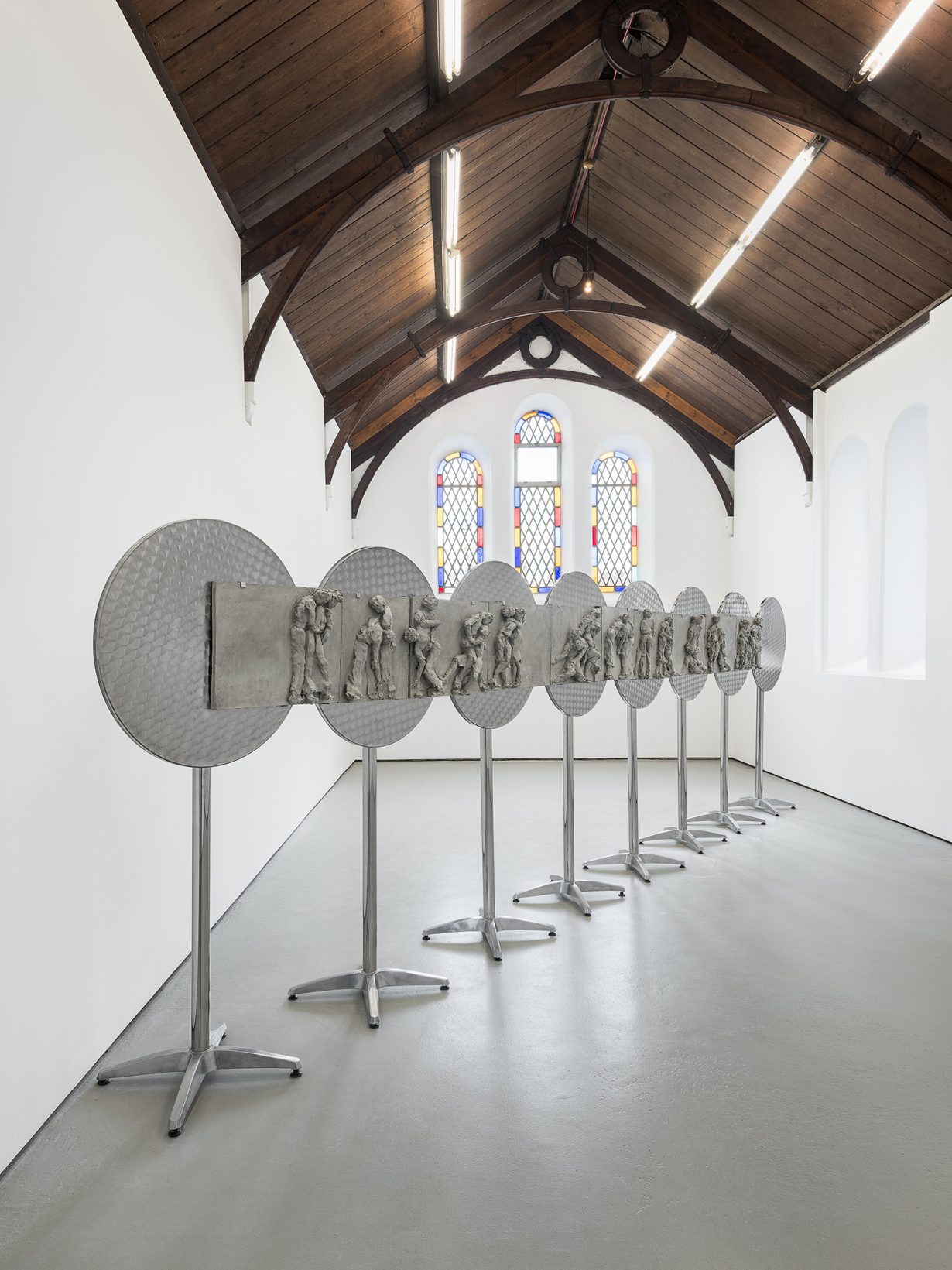Marathon Dance Relief at Lismore Castle Arts casts the Depression-era US in intimate, unmonumental sculpture
‘Dancing is what we make of falling,’ wrote the theorist and poet Fred Moten in his poetry collection The Little Edges (2014). In her newly commissioned work Marathon Dance Relief, Nicole Wermers attends to the spectacle, but also the subjectivity, of human emotion and its associative movements. Taking Depression-era dance marathons in the United States as her subject, she imagines strength and weakness, pleasure and pain, victory and defeat – not as easy binaries or poles apart, but as qualities and effects indiscernible from one another. Marathon Dance Relief bisects the former Victorian church hall of St Carthage Hall, cutting through the space diagonally. Lustrous metallic café tabletops, ubiquitous across modern-day Europe, are lined up and folded vertically to create a series of tondolike panels upon which a ten-part clay relief is mounted. Each segment of the relief depicts a couple, sometimes two or three couples, midmotion; one partner collapsed, exhausted, into the arms of the other, who buckles a little under their combined weight while trying to maintain the qualifying steps: shuffling, arching their back, cradling their partner, moving forward or around.
During the 1920s and 30s, amid rampant unemployment in the US, impoverished couples competed in gruelling dance marathon events for prize money, shelter and regular meals; dancing for days, and sometimes weeks or months on end, with 15-minute intervals for sleep. People paid to watch under the pretence that despite their dirty, swollen and sullen bodies, the contestants were having a good time. For Marathon Dance Relief, Wermers plumbed online images and films of Depression-era dance marathons, recreating, in the first panel, a memorable exchange between Jane Fonda and Michael Sarrazin in They Shoot Horses, Don’t They? (1969) as they dance “over broken bodies and broken dreams”, so the emcee declares. In it, Sarrazin’s head rests heavily on Fonda’s shoulder while she tries to bear his weight, blurring the distinction between physical exhaustion and romantic tenderness. In other panels, Wermers translates sometimes stoic, sometimes limp bodies into a range of fluid and roughly made forms, while leaving her own haptic marks – the odd crescent moon of a nail or mark of a thumb. Rather than set in stone or bronze, or fired and glazed, the air-dried clay of Marathon Dance Relief has a tentative and unfinished quality, as if liable to change, the way that bodies are.

Marathon Dance Relief takes its compositional cues, as Wermers often does, from classical sculpture and largescale reliefs. Unlike the monumentality of famous architectural friezes like the Parthenon Sculptures, this one is intimate in scale, not towering above the viewer but presented at eye height. Wermers’s reliefs constitute a liminal form that imagines relief, in its other sense, as the moment between stasis and action. These works subvert the social order of things, not least the prescriptive roles of gender: classically heteronormative compositions – narrating the throes of passion, the perils of war and victory, and the laborious construction of empire – are traded for androgynous, sometimes same-sex partners; their bodies poised somewhere between arduous effort, utter collapse and a moment of tactical respite. Wermers has long been interested in concealed or hidden forms of labour, both past and present. In a defunct Glasgow office block in 2024, the artist presented a series of ‘reclining females’ raised up not on plinths but on cleaning trolleys, referring to the pink-collar workforce concealed by the ‘night shift’; while in Marathon Dance Relief, the historical labour of dance marathons is dressed up as leisure time. In such works, Wermers exposes the endless conflation of work and leisure for capitalist gain, within which women appear as both the ‘supporting leg’ and object of desire, reflecting their expendable value in the labour and leisure markets.
It is difficult to present contemporary art in historic spaces, but the period pastiche-like quality of Wermers’s presentation makes light of this; it works despite, not because of, the exhibition space. Inspired by fleeting and lowbrow cultural phenomena, rendered in low-stakes material and scaled down, the work feels closer to a mock-up or prototype, as if Wermers is reticent to enter an art-historical canon – one impervious to change. In Marathon Dance Relief, she imagines what is unheroic about labour, exposing both human frailty and resilience. Unlike the singularity of heroism, here the marathons come to represent the intimacy of shared struggle.
Marathon Dance Relief at Lismore Castle Arts, through 25 May
From the May 2025 issue of ArtReview – get your copy.
